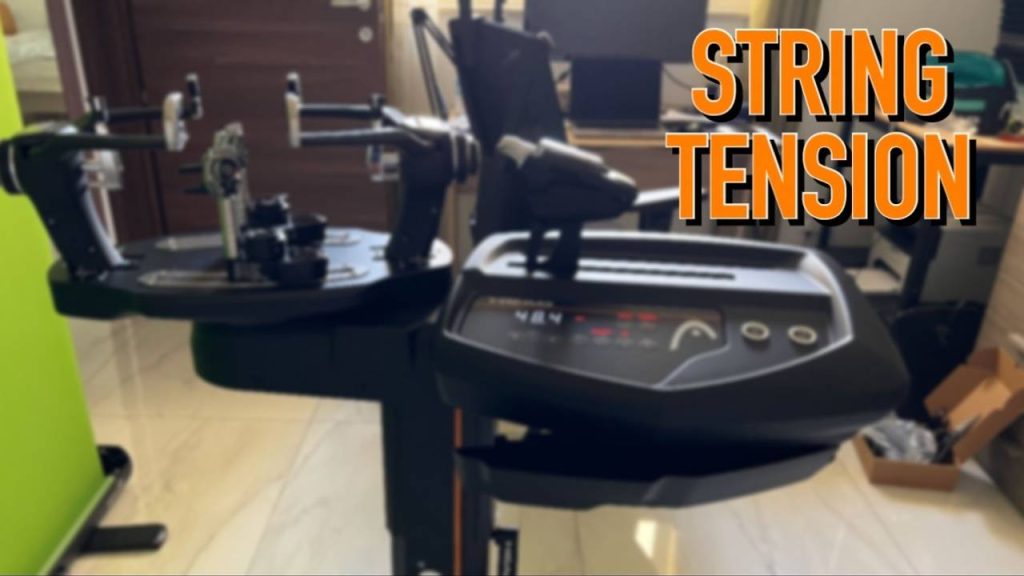The string tensions and gauges decide how much control you want from the racquet. This is highly personal, but most players string their racquets between 20-25 kg these days (44 lbs – 55 lbs). It depends on the racquet and what strings you use. For multifilament and natural gut, you generally want to string towards the 25 kg / 55 lbs. For polyesters you can go lower. There seems to be no limit how low you can go depending on your technique and playing style.
For example, Adrian Mannarino uses 11 kg or 24 lbs in a Babolat Aero Pro Drive GT (Power and spin racquet). So it all depends what you feel comfortable with.
The general trend is that players are using lower tensions on average. The average string tension among the top 500 players in the world is 44 lbs. Most pro players use a full bed of polyester, but many also use a hybrid with a poly and a softer string like gut.
| String Tension | Power | Control | Durability | Feel | Comfort |
| softer | more | less | more | more | more |
| tighter | less | more | less | less | less |
| String Gauge | Elasticity | Durability | Spin | Feel | Comfort |
| thinner | more | less | more | more | more |
| thicker | less | more | less | less | less |
String gauges
Strings come in different thicknesses, so called gauges. The thicker the gauge, the more control and durability. The thinner the gauge, the more comfort and power.
Gauges run from 1.05 to 1.40. The most common ones are 1.20, 1.25 and 1.30. The rest are more unusual.
Often the diameter of a string is not given in millimeters but in the old “gauge”.
The following table helps you convert between these two measures:
| Gauge | Diameter approx. |
| 15 | 1.43 mm |
| 15L | 1.38 mm |
| 16 | 1.32 mm |
| 16L | 1.28 mm |
| 17 | 1.25 mm |
| 17L | 1.20 mm |
| 18 | 1.10 mm |
String tension and weather
The weather and the conditions you play in will affect how the strings play and feel. But there are also other aspects to take into consideration:
1. How long it has been since it came off the stringing machine
2. How hard and with how much spin you hit
3. The balls you use
4. The balls your opponent hits at you
5. The weather
Let’s go through each of them.
1. As soon as the racquet comes off the stringer, the tension is at its highest. But it usually drops 10% or more in the first hour as the string bed settles. Playing with a racquet straight off the stringer might feel stiff. After one hour, it usually feels better.
2. Players that hit with a lot of spin bend and move the strings more. When the strings move, tension quickly goes, and if you hit hard, you will likely break a full bed of poly in a couple of hours. Most players don’t do.
3. Certain balls are softer. Other balls are harder. They have different bounce/feel/heft/liveliness. This will make your shots act and play differently. I like heavier balls that offer better control.
4. If your opponent hits with a lot of spin and/or pace, the shots coming at you will feel heavier, give you less time, and make the string bed feel different. It doesn’t mean it plays differently – but it might feel that way.
5. Understanding how weather and temperatures affect the string bed is essential. Cold/dry weather will stiffen the strings, and warm/humid weather will loosen them. If you play tennis on a hot or humid day, you should ideally have a racquet where the strings are 2-4 lbs higher in tension. And the opposite is true for playing in cold weather. Having a racquet that is strung 2-4 lbs lower is important.
Why pros use different string tensions?
Pro players will adjust their tension requirements indoors as well. If the arena is small, packed with crowds, and thus hot – they need a higher tension.
This is why pro players bring 4-6 freshly strung racquets to a match (sometimes more, it depends on how hard they hit). That means they can adjust the feel of the string bed to:
1. How they hit the ball that day
2. How their opponent’s shots are coming through
3. The balls (new balls are livelier, so that is why many change their racquet then).
4. The weather/temperature
Windy conditions can also impact what tension you want to use.
If you play against the wind, you’d ideally want a looser tension for more help with depth. If you play with the wind, you would like a tighter tension for more control. If the wind swirls around and is unpredictable, going for more control is usually the way to go.
Is it practical for club-level players to follow all this? No, not really, but it’s good to understand. And if you want to be next-level serious about your tennis, having four matched racquets or so with two strung at your reference tension, one strung tighter and one strung looser, is not a bad idea!
I hope this guide gave you an idea of the importance of string tensions and gauges that both pros and club players use to dial in their power.

